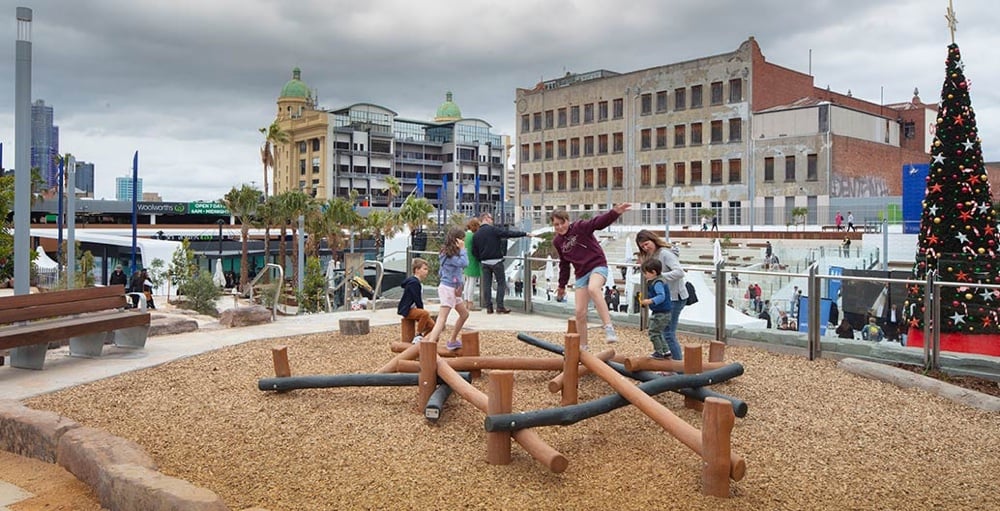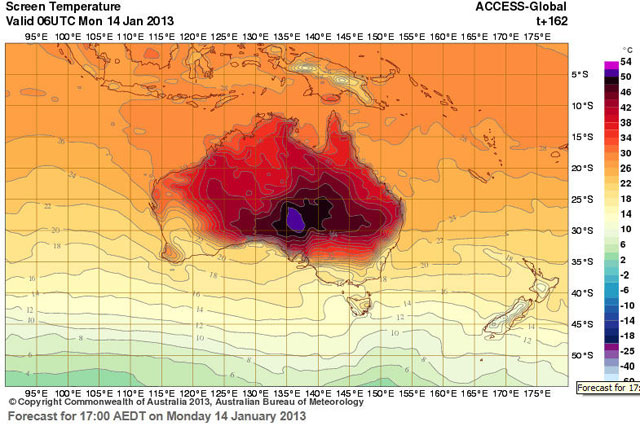
Great reinvention of a former parking lot in south-east Melbourne, Australia. Reclaiming the space from cars, including Saturday night “burnouts,” Prahran Square was designed to recall surrounding landmarks, draw in citizens, and become a true public square, deliberately linking itself to existing spaces.
[T]he square is part of a greater public realm strategy that includes surrounding street, public forecourts and pocket parks to create a new integrated precinct. “All the streets started to become shared, and with Prahran Square, we started to create a civic village, which is a combination of squares, parks, streets,” says Bauer. “That was always the bigger idea, defining little projects that all slowly start to weave together.”
The new installations were divided in various zones, all overlooking the central event space and providing varied uses.
A zig-zag ‘forest’ walk and playgrounds, sloped lawn, art and flowering garden-beds all triggered familiar activities for local residents to enjoy. Each corner of the square too has a different materiality, a different character and different things to see and do.
The whole project is now better integrated in the surrounding neighbourhood and welcomes a number of different needs and communities.
It’s very eclectic, it has something for old and new communities, passing populations of young people, different national backgrounds, night spots, market-going families, the fashion people, elderly and infirm people, people watching, meeting up, just hanging out.

Photos by John Gollings with permission from Foreground.
Ornithologists have collected a number of eyewitness accounts from Australia of three types of birds that deliberately set fires to flush out prey from grassy areas.
Black kites (Milvus migrans), whistling kites (Haliastur sphenurus) and brown falcons (Falco berigora) all regularly congregate near the edges of bushfires, taking advantage of an exodus of small lizards, mammals, birds and insects — but it appears that some may have learnt not only to use fire to their advantage, but also to control it.
“At or around an active fire front, birds — usually black kites, but sometimes brown falcons — will pick up a firebrand or a stick not much bigger than your finger and carry it away to an unburnt area of grass and drop it in there to start a new fire,” says Bob Gosford, an ornithologist with the Central Land Council in Alice Springs, in the Northern Territory, who led the documentation of witness accounts. “It’s not always successful, but sometimes it results in ignition.”
(via @christopherjobs)
You might remember this 2015 Atlantic piece about what happened when Melbourne gave each of the city’s trees its own email address for reporting arboreal problems: people started writing love letters to the trees.
“My dearest Ulmus,” the message began.
“As I was leaving St. Mary’s College today I was struck, not by a branch, but by your radiant beauty. You must get these messages all the time. You’re such an attractive tree.”
This is an excerpt of a letter someone wrote to a green-leaf elm, one of thousands of messages in an ongoing correspondence between the people of Melbourne, Australia, and the city’s trees.
More than three years later, people are still writing. ABC News has collected some of the most interesting emails and presented them alongside photos of the trees they’re directed to.

Another admirer wrote to a Moreton Bay Fig tree:
You are beautiful. Sometimes I sit or walk under you and feel happier.
I love the way the light looks through your leaves and how your branches come down so low and wide it is almost as if you are trying to hug me. It is nice to have you so close, I should try to visit more often.
In the past two weeks, the results of three surveys and studies about the Earth’s climate have been released: a paper on a possible dramatic climate shift, a survey of coral bleaching at the Great Barrier Reef, and a study on the West Antarctic ice sheet. All three investigations tell the story of climate change happening quicker than was previously anticipated.
From the paper published last week by former NASA climate scientist James Hansen and a number of colleagues:
Virtually all climate scientists agree with Dr. Hansen and his co-authors that society is not moving fast enough to reduce emissions of greenhouse gases, posing grave risks. The basic claim of the paper is that by burning fossil fuels at a prodigious pace and pouring heat-trapping gases into the atmosphere, humanity is about to provoke an abrupt climate shift.
In Australia, more than 40% of the Great Barrier Reef has been damaged by coral bleaching.
Scientists who have dedicated their careers to studying the reef and its ecosystem say the current bleaching is unprecedented, and perhaps unrecoverable. The emotion in their responses so far have been palpable.
“I witnessed a sight underwater that no marine biologist, and no person with a love and appreciation for the natural world for that matter, wants to see,” said Australian coral scientist Jodie Rummer in a statement, after spending more than a month at a monitoring station in the Great Barrier Reef.
Though corals comprise only about 0.2 percent of the global oceans, they support perhaps a quarter of all marine species.
And just yesterday, a study on the West Antarctic ice sheet was released that says the ice sheet could melt much faster than previously thought, raising global sea levels by 3 feet in less than 90 years. Even the normally staid NY Times invoked the Sword of Damocles in the lede.
The great ice sheet, larger than Mexico, is thought to be potentially vulnerable to disintegration from a relatively small amount of global warming, and capable of raising the sea level by 12 feet or more should it break up. But researchers long assumed the worst effects would take hundreds — if not thousands — of years to occur.
Now, new research suggests the disaster scenario could play out much sooner.
Continued high emissions of heat-trapping gases could launch a disintegration of the ice sheet within decades, according to a study published Wednesday, heaving enough water into the ocean to raise the sea level as much as three feet by the end of this century.
Miami might not make it to the end of the century.
Oh and BTW, the maximum extent of sea ice in the Arctic was a record low in 2016, February was a total Messi-esque outlier in terms of how unusually hot it was, March, while not as warm, will still be the hottest March ever, and just look at the 2016 trend in the first chart here.
You can think of the Earth as a massive machine, with many interconnected, resilient, and redundant systems. For a long time, humans thought it was too big for our actions to affect this machine in a meaningful way. But the Industrial Revolution’s release of hundreds of millions of years of stored greenhouse gases in less than 300 years put a strain on that entire machine. We didn’t notice that strain for a long time, but we’re starting to now in the form of higher temperatures, weird weather, bleaching coral reefs, rapidly melting ice sheets in Greenland & Antarctica, and dozens of other ways. I hope there’s still time to do something meaningful about it before the slower moving parts of the machine fail permanently.
The forecasted temperature in the interior of Australia is so high for next Monday that the country’s Bureau of Meteorology has had to add an extra color code at the top end of the temperature scale for REALLY FUCKING HOT.

The bureau’s head of climate monitoring and prediction David Jones said the new scale, which also features a pink code for temperatures from 52 to 54 degrees, reflected the potential for old heat records to be smashed.
“The scale has just been increased today and I would anticipate it is because the forecast coming from the bureau’s model is showing temperatures in excess of 50 degrees,” Jones told Fairfax newspapers.
Australia’s all-time record temperature is 50.7 degrees, set in January 1960 at Oodnadatta in the state of South Australia.
The nation as a whole experienced its hottest day on record on Monday with the average maximum temperature across the country hitting 40.33 degrees, surpassing the previous mark of 40.17 degrees set in 1972.
I feel like climate change needs a Steve Jobs to kick everyone’s ass into action on this, iPhone announcement-style. “Unprecedented polar ice cap melt, new colors on Australia’s weather map, massive East Coast hurricanes, are you getting it? These are not three separate incidents. This is one global pattern. And we are calling it anthropogenic climate change. [wild applause]” (via @ftrain)
A 2006 paper that appeared in Injury Prevention analyzed the possible results of the 1996 gun law reforms in Australia. The most striking result: in the 18 years before tougher laws were passed, there were 13 mass shootings in Australia…and none in the 10.5 years afterwards.
Results: In the 18 years before the gun law reforms, there were 13 mass shootings in Australia, and none in the 10.5 years afterwards. Declines in firearm-related deaths before the law reforms accelerated after the reforms for total firearm deaths (p = 0.04), firearm suicides (p = 0.007) and firearm homicides (p = 0.15), but not for the smallest category of unintentional firearm deaths, which increased. No evidence of substitution effect for suicides or homicides was observed. The rates per 100 000 of total firearm deaths, firearm homicides and firearm suicides all at least doubled their existing rates of decline after the revised gun laws.
Conclusions: Australia’s 1996 gun law reforms were followed by more than a decade free of fatal mass shootings, and accelerated declines in firearm deaths, particularly suicides. Total homicide rates followed the same pattern. Removing large numbers of rapid-firing firearms from civilians may be an effective way of reducing mass shootings, firearm homicides and firearm suicides.
Australia celebrated Toad Day Out this past weekend, resulting in the deaths of thousands of toxic cane toads.
Cane toads were introduced to north Queensland canefields from South America in 1935 to eat pest beetles. The slimy interlopers couldn’t jump high enough to reach the beetles at the top of the cane stalks and, instead, rapidly spread in search of food. Millions of them now threaten many local species and spread diseases such as salmonella across northern Australia.
Ick. The hallucinogenic amphibians were profiled in the documentary Cane Toads: An Unnatural History. Ribbit in peace.
In terms of population, the Bahamas won more medals at the 2004 Summer Olympics than any other country, by more than double. For a country of ~21 million, the super-fit Australians make a good showing on the list.
Update: And here’s a listing of medals rated by wealth. (thx, noah)
A list of plans that worked too well. For instance, a sunscreen campaign in Australia resulted in vitamin D deficiencies.
A French map shows that the Portuguese were the first Europeans to discover Australia in the early 1520s, almost 250 years before Captain Cook claimed them for Britain. “‘The Vallard cartographer has put these individual charts together like a jigsaw puzzle. Without clear compass markings its possible to join the southern chart in two different ways. My theory is it had been wrongly joined.’ Using a computer Trickett rotated the southern part of the Vallard map 90 degrees to produce a map which accurately depicts Australia’s east coast.”









Stay Connected